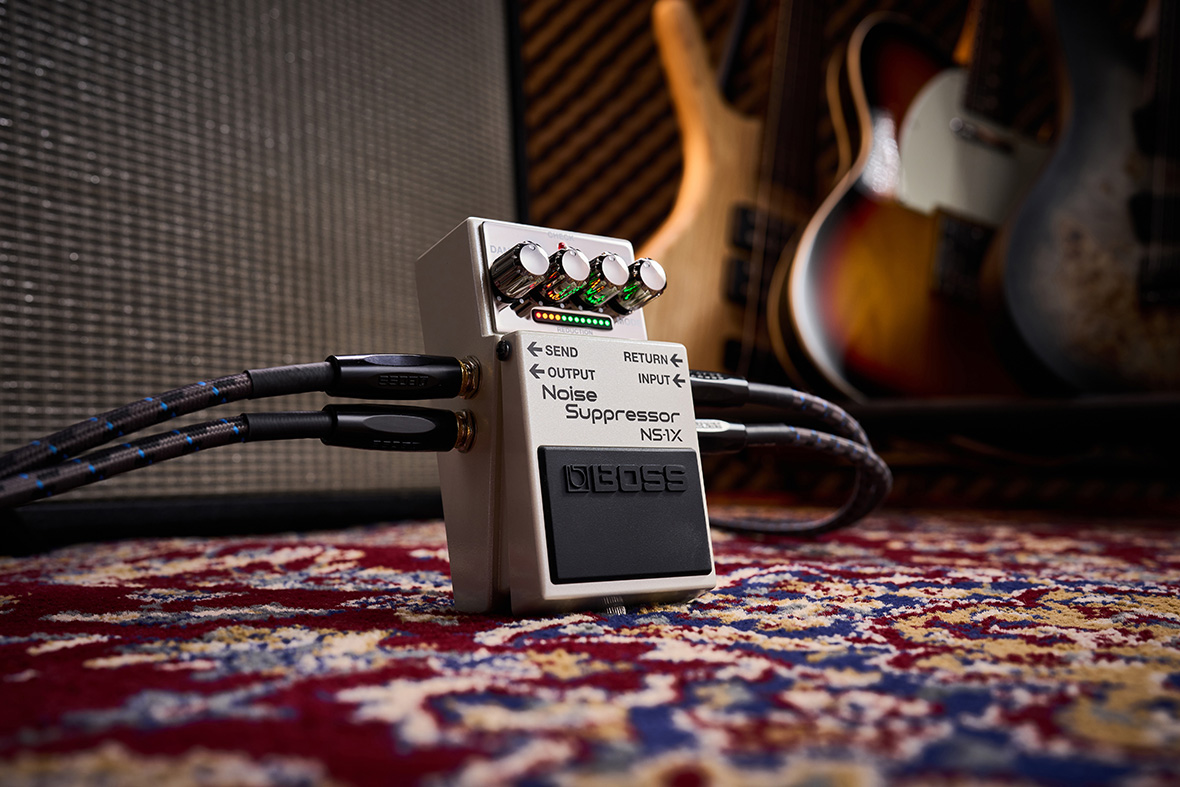At their core, noise gates and suppressor pedals cut or reduce any unwanted noise in a signal chain. This may seem a dull task for an effects pedal, but that doesn’t make them any less essential. The reputation is also slightly misleading. A noise gate can be the cornerstone of a great guitar tone. It can define a bold pick attack, breathe new life into distortion pedals, and harness amplifiers at high volumes. Let’s investigate the world of noise gates and suppressor pedals.
What a Noise Gate Does
A noise gate identifies the intended, deliberate sound of the guitar and differentiates it from any unwanted noise. This noise can be amp/pedal hiss or EMI (electromagnetic interference). A noise gate can shut down the unwanted signal. Via user-defined settings, it allows the natural note decay to continue cleanly.
When to Use a Noise Gate
Numerous situations and conditions exist where a noise gate can be a helpful addition to an effects chain. Unwanted noise can be a problem for guitarists in many different ways. As such, players can implement noise gates in multiple ways depending on the situation.
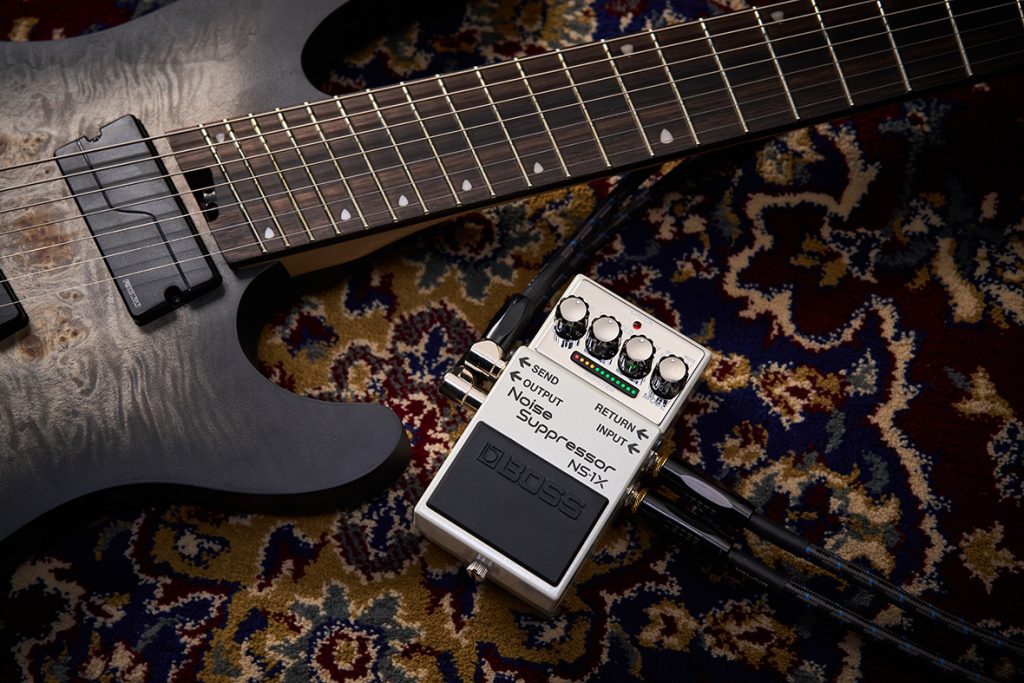
One of the most common applications for a noise gate is in the effects loop of a high-gain amplifier. Driving a 100-watt amp to its extreme can create some of the world’s most loved guitar tones. However, it comes at the expense of a lot of amp hum and hiss. By inserting a noise gate into the effects loop, the pedal can eliminate unwanted amp noise while reacting naturally to tone, sustain, and pick attack.
"One of the most common applications for a noise gate is in the effects loop of a high-gain amplifier."
This problem isn’t unique to high-gain-loving musicians. Even the cleanest amp will, at high volumes, produce some hiss and noise. Many vintage-style amplifiers work best at the deafening volumes. But, the louder the amplifier, the louder the unwanted amp hiss and noise. A noise gate can be an intelligent, easy solution to retain all the best features of a loud tube amp while eliminating unwanted noise.
EQ settings on an amplifier, EQ pedal, overdrive, or preamp can also cause unwanted noise. Any frequency boosting to the EQ of an amp or pedal adds gain to the circuit. This can be especially prevalent when boosting high-mids and treble frequencies.
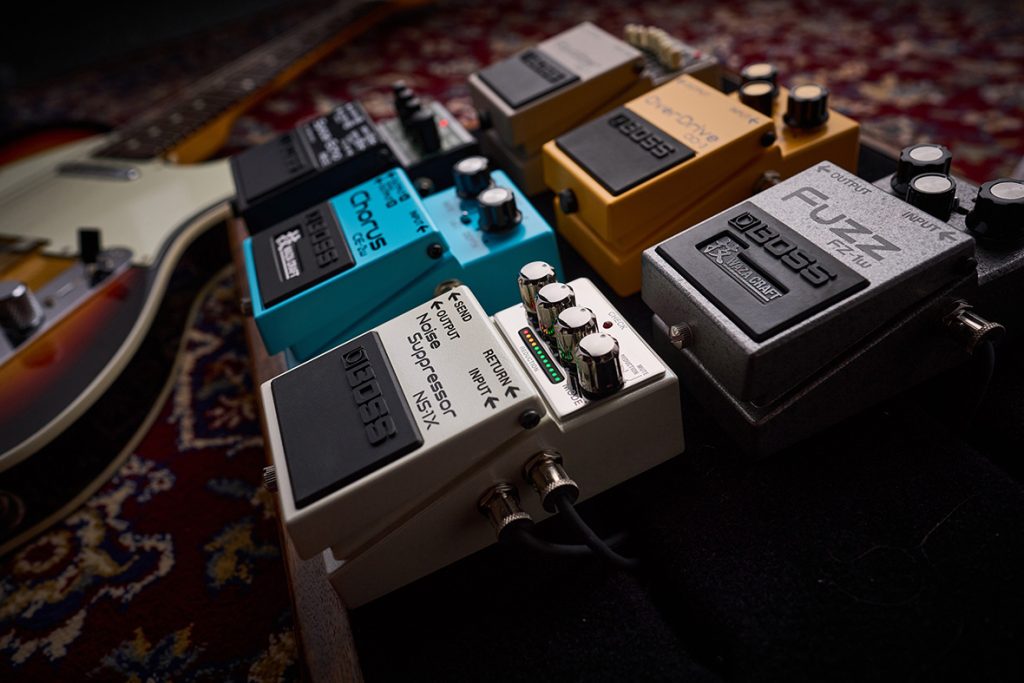
Other Noise Sources
Pickups are another source of unwanted noise. There can be numerous reasons for this. Some vintage pickups can become microphonic. They retain their nasal vintage tone but introduce too much ambient sound and harmonic content. Poorly fitted, underwound, and single-coil pickups can also be noisy. Single coil pickups, primarily with overdrives and high-gain amplifiers, can create a lot of hiss and hum.
EMI is also a widespread source of noise in a guitar setup. It can be frustrating to identify the source, and it is often the result of multiple smaller factors. These include long effects pedal chains, cheap patch cables, the proximity of a lighting rig, or even the quality and condition of the power source to the amplifier. Guitarists can control, temper, and eliminate all these issues by effectively using a noise gate or noise suppressor.
"The fast clamping of a sensitive noise gate has become a quintessential part of the complex rhythmic note stabs of djent music."
Noise Gate Versus Noise Suppressor
There is a subtle but distinct difference between noise gate and noise suppressor pedals. Noise suppressors reduce unwanted noise below a user-defined threshold, maintaining a natural decay. In contrast, a noise gate clamps down and eliminates any signal below a certain threshold. This makes the noise gate a more harsh, less responsive option.
Still, this doesn’t make one better than the other. Differences between the two depend entirely on the application. The fast clamping of a sensitive noise gate has become a quintessential part of the complex rhythmic note stabs of djent music. Its sound emphasizes the stuttering rhythms in a way that a more natural-sounding noise suppressor might not.
Comparing the NS-2 and NS-1X
The BOSS NS-2 has been in continuous production since 1987 and is a best-selling staple of the BOSS stompbox series of effects. Beloved by international touring bands like Metallica, Slipknot, U2, and The Dillinger Escape Plan, the NS-2 is an industry standard in noise suppression.
It is an all-analog circuit with a more traditional approach to noise suppression. While the NS-2 was light years ahead of other noise suppression effects, it is most effective for simple, relatively aggressive gating with some excellent, intuitive features for natural decay.
"The NS-1X Gate mode provides ultra-fast heavy gating to ensure staccato, high-gain riffs remain sharp and distinct."
The NS-1X is an all-digital circuit and utilizes BOSS MDP (Multi-Dimensional Processing) technology. This advanced tech allows the NS-1X to intelligently silence noise without affecting natural tone and feel. Reduction mode keeps rigs quiet in any general playing setup. The result is ideal for players looking for a more natural, organic guitar tone. Gate mode provides ultra-fast heavy gating to ensure staccato, high-gain riffs remain sharp and distinct.
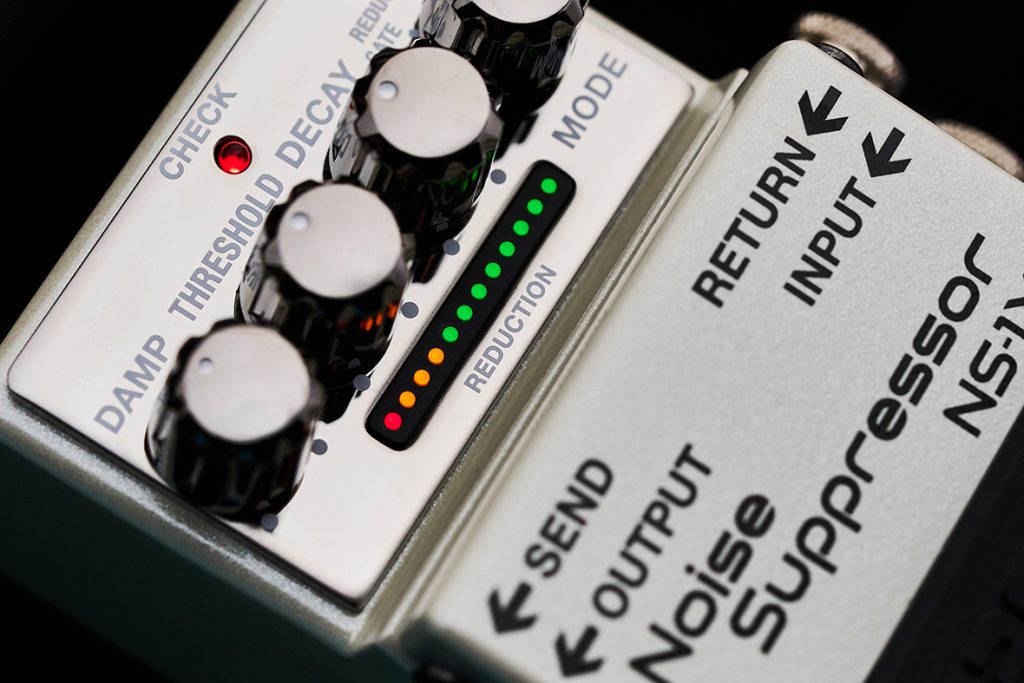
Noise Gate and Tone
The most common reason for guitar players with noisy setups to avoid using a noise gate is due to a traditionally perceived view. Some feel noise gates and noise suppressors suck the life out of guitar tones, leaving them artificial, muffled, and generally lacking bite and sparkle.
This might be true of some more straightforward analog noise gates. However, the MDP technology at the core of the NS-1X analyzes the input signal on multiple levels in real time. This enables ultra-detailed processing that provides the right amount of noise reduction for any style.
Noise Gate Pedal Controls
Damp: This controls the maximum amount of noise reduction. Higher settings make the noise reduction effect stronger and clearer. Lower settings reduce the strength of the effect, which may provide more natural results with some playing styles.
Threshold: Determines the level when the noise suppression begins. In Reduction mode, start with the knob at the lowest setting and turn it clockwise until the noise disappears. In Gate mode, start at the highest setting and gradually turn the knob down until you achieve the attack response that feels right to you.
Decay: Determines when the selected mode reaches maximum noise suppression. Start at the lowest setting, then turn the knob clockwise for a more natural decay.
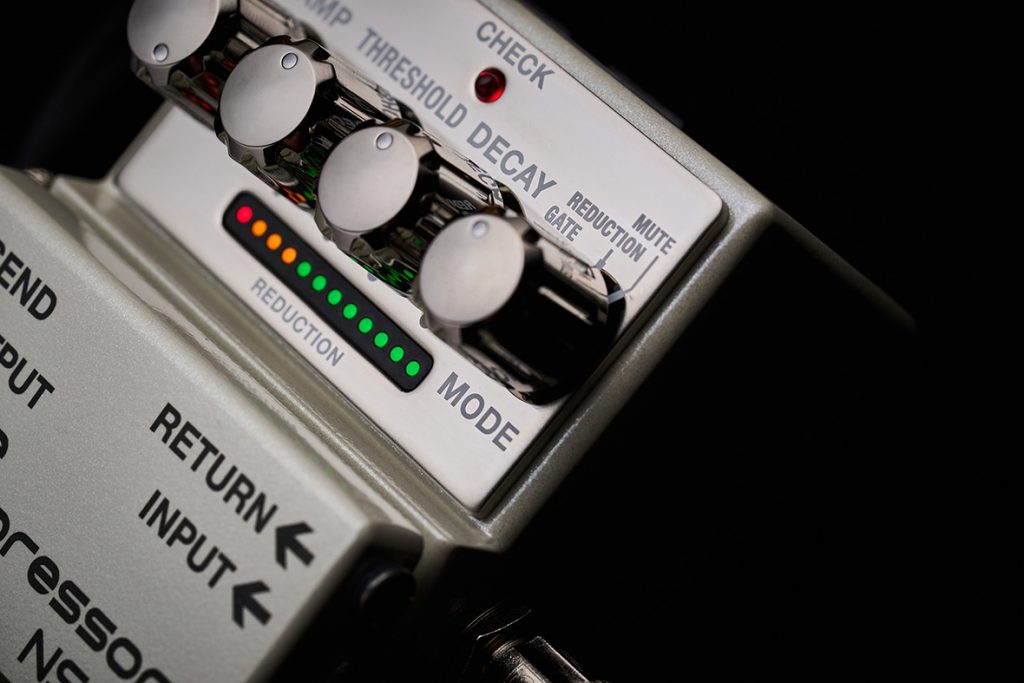
Reduction Indicator: Displays the current noise suppression status. This gives the user a visual aid when setting the desired noise reduction, much like with a compressor.
Reduction Mode: Reduction mode is for general noise suppression applications. It is more subtle than Gate mode and eliminates errant noise while retaining the maximum natural note decay and tone.
Gate Mode: Gate mode provides ultra-fast noise elimination for tapping, sweep picking, and heavy rhythm styles that rely on high gain. It acts as an effect to enhance definition and is stylistically suited to djent, metal, and progressive metal players.
Mute: Mute mode silences the instrument signal when the pedal switch is on. The pedal operates in user-selectable Reduction or Gate mode when the switch is off.
Noise Gate In An Effects Chain
Unlike most other effects pedals, a Noise Gate works in multiple positions in an effects chain. There are several methods depending on the setup and whether it’s for natural noise reduction or aggressive noise gating.
In-Line
For many players, high-gain distortion and the inherent noise and hiss that come with it come from a distortion, fuzz, or overdrive pedal. The most common way to eliminate unwanted noise with a noise gate is to position the gate after the distortion pedal in a simple chain.
This method is easy to set up and allows the noise gate to focus directly on the distortion pedal as the source of unwanted noise. If you’re running several gain or EQ pedals, it’s best to position the noise gate after all of them. The noise gate will reduce the noise of any pedals in front of it, so it’s best to place it somewhere in the chain after all dirt pedals.
"If you're running several gain or EQ pedals, it's best to position the noise gate after all of them."
It’s important to note that a noise gate should come before any delay and reverb pedals. Positioning it after will cause it to treat any delay tails or reverb decay as unwanted noise and will attempt to reduce its impact.
Amplifier Effects Loop
If the source of your high-gain drive tone is your amplifier, then place the noise gate directly into the amplifier’s effects loop. This positions the noise gate after the amplifier’s preamp, the amplifier’s gain stage, but before the Power section. The location allows the gate to act as the last effect source ahead of the speaker, sculpting exact definition, clarity, and attack.
Four-Cable Method Using High-Gain Pedal
It’s important to note that while the first two methods are straightforward, they have limited capabilities and effectiveness and work best with simple, minimal setups. When a noise gate comes after a distortion pedal, the gate receives both the guitar signal and the pedal’s hiss and hum as one signal. It then needs help identifying and separating errant noise from the intended guitar sound. Running the noise gate at the start of your effects chain is often much more effective, with the guitar or bass connected directly to its input. Connect any gain pedals via the noise gate’s effects loop.
This allows the noise gate to identify the clean guitar signal and the errant noise of the distortion pedal as two separate sources. It can then accurately reduce and cut any unwanted sound while being able to focus on and tighten the natural guitar tone.
"When a noise gate comes after a distortion pedal, the gate receives both the guitar signal and the pedal's hiss and hum as one signal."
Four Cable Method Using High-Gain Amp
This method works just as well for players using an amplifier for their high-gain tones. Run the guitar directly into the input of the noise gate. The noise gate’s output should then run straight into the effects return of the amplifier, the noise gate’s send to the input of the amplifier, and the amplifier’s effects send to the return of the noise gate.
This setup allows the pedal to identify and separate amplifier noise and clean guitar signal. It uses the clean guitar signal from the input as a complex trigger for allowing the desired guitar tone to pass through. Remember that the NS-1X and NS-2’s maximum input level is +7dBu. This means that unintentional clipping may occur at the return input stage depending on the specs of an amp’s send.
"Reduction mode on the NS-1X preserves natural note decay and playing dynamics while focusing specifically on hum and hiss."
Noise Gate Applications
There are numerous applications for a noise gate. It works as an effects pedal to enhance percussive tones or as a utility to clean up errant noise and EMI. Metal and djent are genres that rely on high-gain guitar tones. The precise, almost unnatural gated effect provides exaggerated precision and defined staccato rhythms. The Gate mode on the NS-1X is ideal for super clear, clean articulation. It’s both fast and very responsive.
Single coil pickups, on the other hand, need a gentler touch. They naturally produce a lot of unwanted microphonic noise, especially when paired with a loud valve amp. Still, the single coils’ dynamics and nuance make them so desirable. The Reduction mode on the NS-1X is ideal for this situation. It preserves natural note decay and playing dynamics while focusing specifically on hum and hiss.

Bass and vocals can both require similar treatment to single coil pickups. Their natural decay and subtle dynamics should remain, with only errant hiss and hum removed. The MDP technology in the NS-1X is fast and transparent. It eliminates the unnatural attack and decay artifacts that come with conventional noise suppressors. Moreover, it delivers detailed processing with just the right amount of noise reduction.
